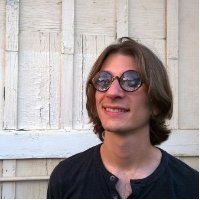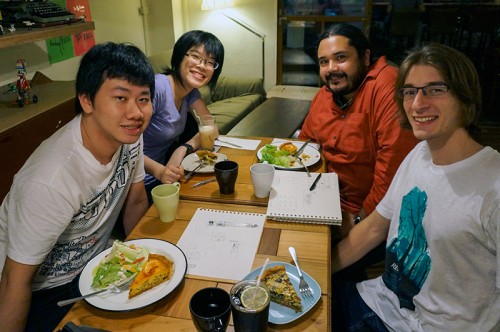
Russell Singer
Each term, Art Center has the great honor of presenting the Student Leadership Award to a graduating student. This award fulfills Art Center’s vision of educating artists and designers who are not only leaders within their professional fields, but leaders in their communities. Based on recommendations from faculty, staff and students, this award recognizes a student who has provided leadership through participation in Art Center’s campus life, community outreach, student organizations and department initiatives.
This past Saturday, Graduate Transportation Systems Design grad Russell Singer accepted Art Center’s Student Leadership Award for the Spring 2015 term. He then listed his thank yous and fired off a question that appeared so seemingly simple it almost appeared to be pandering the crowd gathered in the Pasadena Civic for Art Center’s Spring 2015 Graduation ceremony.
What is design?
“We take it for granted, but I think it’s a profound question that is deceiving in its brevity,” Singer explained before repeating his question, which took on new layers of depth and complexity with each invocation and inquiry encapsulated in the text of Singer’s speech below.
“So what is design? Is it rows of shiny objects on a shelf, or is it a conversation between people at a distance? Is it added value to differentiate one company’s industrial process from another, or is it a collaboration to achieve a common goal? Is it trend and market analysis, or is it a long string of buzzwords that leverage the essence of connected systems-thinking to provide users with a seamless-experience tactile-environment of cloud-based intelligent peer-driven solutions? Is it a high performance car made reminiscent of a stealth fighter jet, or is it riding the bus to better understand an underrepresented user group?
I think the question of what is design is as important today as it has even been. We see more and more specialties introduced and more and more separation between professionals. And yet as our titles as designers become more specific, the world around us blurs. Are today’s cars, cars? Or are they robots? Are today’s products objects, or are they ecosystems? These are opposing trends, and I worry that tomorrow’s design might suffer for a lack of connections in a modern world that lacks clarity. This is a contradiction.
My department director Geoff Wardle has some thoughts on contradictions. Geoff often refers to the “opposable mind,” which has become a fundamental part of what I now view as design. The opposable mind is the ability to hold two seemingly contradictory thoughts in your mind at the same time, to evaluate them equally, and attempt to find the opportunity that dissolves the contradiction. Contradictions like: Cars are beautiful and exhilarating and lovable for so many reasons. But cars are also the most visible modern symbol for how indiscriminate consumption is driving us to a brink. Opportunities like: An electric sedan faster than a Lamborghini, which can be upgraded as simply as downloading an update, cutting out designed obsolescence.
With my first project here I was presented with many contradictions both personal and design related. We were tasked with evaluating the transportation system at Art Center, and its impact on our community. We had goals to reduce traffic in the neighborhood, to reduce the environmental impact of the school and, if possible, to reduce the costs associated with transportation.
We interviewed students, faculty, staff, with questions about transportation. But what we got were insights about people. We quickly realized if the goal is to increase carpooling and the obstacle is people who live far apart and feel emotionally disconnected, you cannot solve that problem with a faster vehicle. If the goal is to encourage bicycle usage at a school where time is more valuable than money, then a better bicycle falls short of being an answer.
We used the same tools to generate answers for these problems that you would for any design challenge: iterative sketching, model making, benchmark comparisons. But we applied them to our community. We benchmarked Ghandi: “Be the change you wish to see,” followed shortly by an increase in carpooling, cycling, and EV ownership within our department. Would you believe me if I said DIY club started as a sketch on the wall in the studio? Or that community initiatives have benefitted from focused design critique? Or even that industrial partnerships came about through post-it note brainstorming? Following this experience, I have to view these types of outcomes as part of the design process.
In hindsight, I suppose you could view my efforts in the years following this project as an extension of this initial brief—a continued pursuance of the design goals enumerated in our studio. I hope it’s not presumptuous to view today as a success criterion, not for me, but for our department and therefore our school as a whole, in achieving the goals laid out by our faculty on that first project.
If I might be bold enough to offer any advice, it would be to stay open, seek out projects that require you to learn, know the limits of your skill but accept no limits on its application.
Those who make a habit of finding opportunities find them where others do not look—in between disciplines or hidden behind a contradiction. So don’t ever shy away from the negative associations about the things you love. Not only is this time in history too fragile and precious to do so, but that is also where you will find success. If, you exercise your “opposable mind.”
I don’t presume to have a defined answer to the question: What is design? But I think a good designer has to accept some blurriness in the answer. And I think it is a good question to consider… today.”
During his first term, Russell Singer started Dimensional Classroom, a volunteer education program that used 3D printing and CAD to teach children the basics of math, engineering, design and the visual arts. He then founded DIY Club, an Art Center student group whose members explore methods and learn new skills in a low-risk club setting. Under Singer’s leadership, DIY Club partnered with EcoCouncil on a project in which students designed and built furniture for the Judy Slasky Memorial Rooftop Garden at South Campus. As a Student Government representative for all graduate students, Singer focused on creating educational opportunities and seeking out and addressing concerns of the student body. While at the College, he also helped create Art Center’s first ever student-taught, for-credit course IntraProject, a studio that promotes improving the campus through design, which he also taught for its first two terms.

Sharing drawing techniques and opinions on design at National Taiwan University of Science and Technology‘s (NTUST) International Summer Design Workshop are (L to R) Jr Feng Kwan, Ying-Hsiu Chen, Raul-David Poblano and Russell Singer.









Wow I am a designer too new in the field you mark for my inspiration thank you for such a nice post !